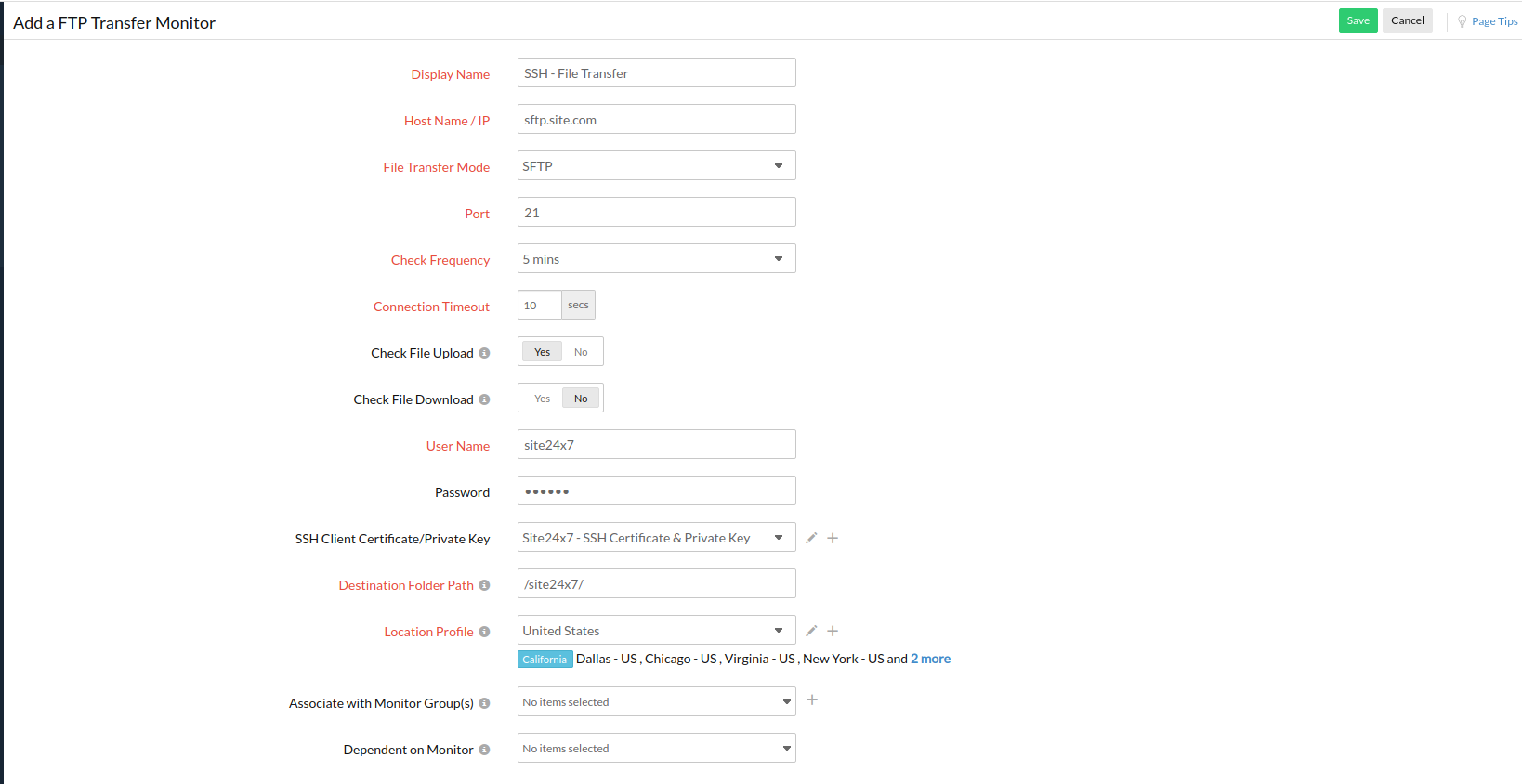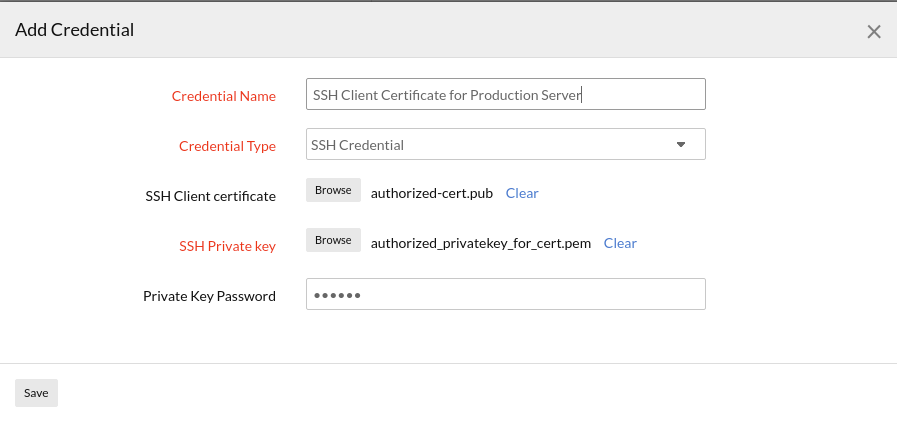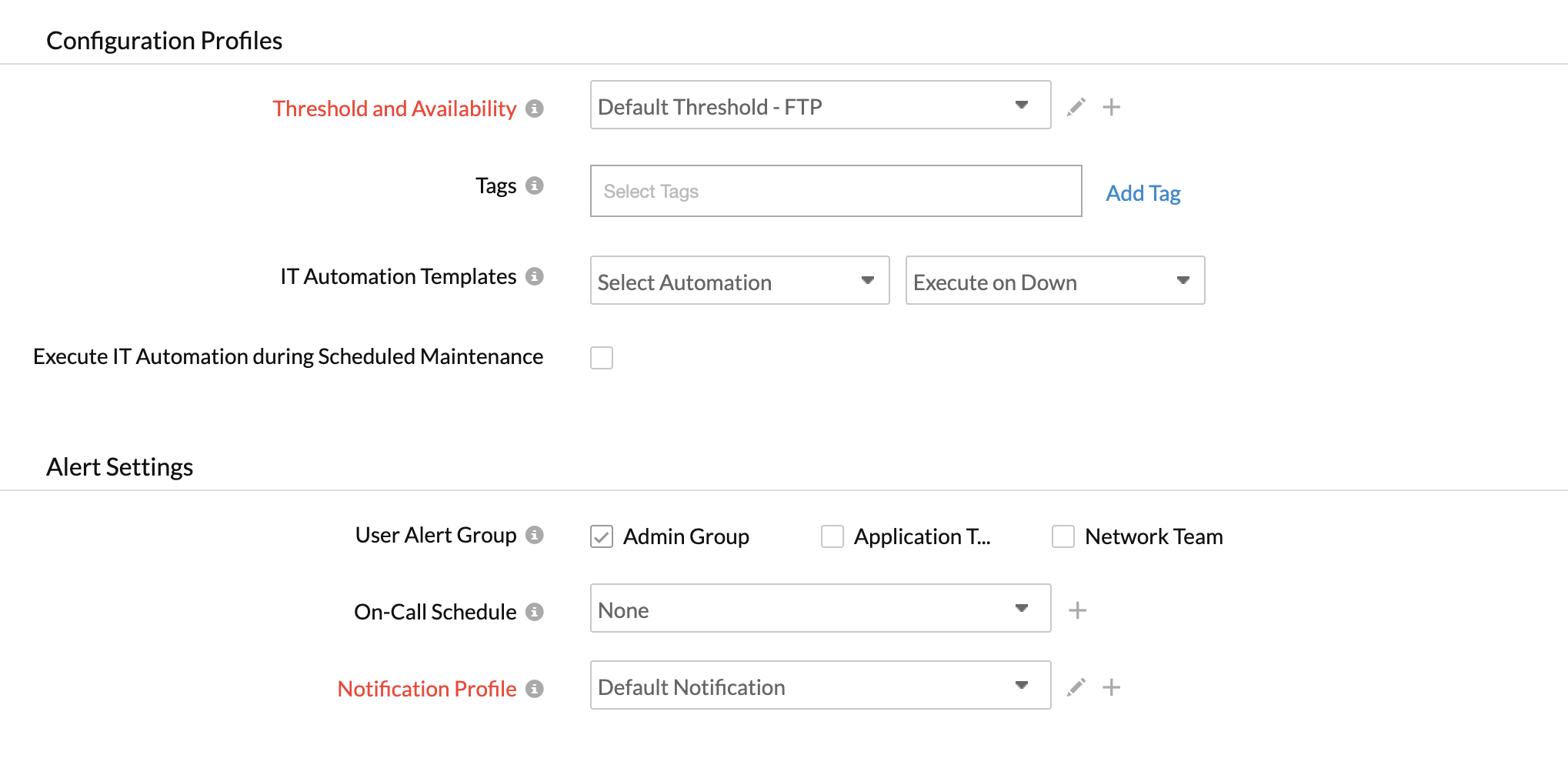FTP Transfer
Monitor the FTP Server by testing the uploads and downloads. Track the round-trip-time, file upload time, file download time of your FTP servers and get alerted instantly via Email/SMS/PDF/RSS.
Add an FTP Transfer Monitor
- Click Admin > Inventory > Monitors > Add Monitor.
- Select FTP Transfer in Add Monitor screen.
- Specify the following information to add the monitor:
- Display Name: Provide a name for the FTP Server, which you want to monitor.
- Host Name: Specify the name of the host on which your server is hosted.
- File Transfer Mode: Select the file transfer mode from the drop down list. The list of modes available are FTP, SFTP, FTPS(SSL), FTPS(TLS).
- Port: Specify the port number from which you FTP server can be accessed. The default port will be set as 21.
- Timeout: Specify the time in seconds needed to establish a connection with the host. If the connection is not established within the specified time, a "Connection Error" message will be reported.
- Check File Upload: Use the toggle button to enable or disable this option. When enabled, it checks for the upload performance via your FTP server by uploading a .txt file of size 10 KB to your FTP server.
- Check File Download: This option checks for the download performance of your FTP server where the .txt file already uploaded in the destination folder will be downloaded to our servers. If only the download option is enabled , then you need to manually upload .txt file and place it in the destination path.

- Username: Specify the username of the FTP server.
- Password: Provide a password for the FTP server.
NoteThis is not a mandatory field. Site24x7 allows anonymous FTP logins.
- Client Certificate: Choose an appropriate Client Certificate from drop-down to authenticate the transfer of data using SSL authentication. The certificate should be a PKCS#12 file. This is applicable only for FTPS (TLS) and FTPS (SSL) file transfer modes.
- SSH Client Certificate/Private Key: Choose an appropriate SSH Client Certificate from the drop-down to authenticate the transfer of data over the SSH server that requires authentication using a Private Key file. This will be applicable only for SFTP file transfer mode.
In case of FTP Transfer monitors, the following additional fields will be available in the Add Credential pop-up during the Credential Profile creation.
- SSH Client Certificate: Upload the certificate file signed with the authorized CA server's Private Key.
- SSH Private Key: Upload the appropriate Private Key of the configured SSH Client Certificate file. If the SSH Client Certificate is not configured then upload the Private Key file which is whitelisted in the end server's authorized Key list.
- Private Key Password: Provide the passphrase to decrypt the configured Private Key file if the configured Private Key file is password protected.

- Destination Folder Path: Specify the path of the destination folder. For monitoring/root destination path, you need to enter a valid user name and password.
- Check Frequency: Choose the required polling frequency.
- Location Profile: Select a location profile from the drop down list from where the FTP server will be monitored. You must configure at least one primary location for monitoring. You can either pick IPv6/IPv4 locations or set-up an On-Premise Poller to serve as a monitoring station.
To know more, refer Location Profile. - Associate with Monitor Group: You can associate your monitor with multiple monitor groups by selecting the relevant monitor groups from the drop down list. This allows in logical grouping of your monitors.
To learn how to create a monitor group for your monitors, refer Monitor Groups. - Dependent Resource: Select a monitor from the drop-down list to choose it as your dependent resource. You can add up to 5 monitors as dependent resources. Alerts to your monitor will be suppressed based on the DOWN status of your dependent resource.
NoteConfiguring a dependent resource and suppressing alerts based on the dependent resource's status is part of providing you with better false alerts protection. Learn more about alert suppression at monitor level.
NoteIf you select "None" in the dependent resource field, alerting will progress as per your normal configuration settings. No alerts will be suppressed in this case as the monitor doesn't have any dependent resource.
NoteMultiple monitor group support for monitors allow a monitor to be associated with multiple dependent resources in different monitor groups. If during a normal monitor status check, any one of these dependent resources' status is identified as DOWN, the alert for the monitor will be automatically suppressed. However, the dependency configuration at monitor level is always given the higher priority over any other monitor group level dependency configuration for suppressing alerts.
- Specify the following details for configuring profiles:
- Threshold and Availability: Select a threshold profile from the drop down list or choose the default threshold set available and get notified when the resources cross the configured threshold and availability.
To create a customized threshold profile, refer Threshold and Availability. - Tags: Associate your monitor with predefined Tag(s) to help organize and manage your monitors creatively. Learn how to add Tags.
- IT Automation: Select an automation to be executed when the website is down/trouble/up/any status change/any attribute change. The defined action gets executed when there is a state change and selected user groups are alerted.
To automate corrective actions on failure, refer IT Automation.
- Alert Settings:
- User Alert Group: Select the user group that need to be alerted during a outage. To add multiple users in a group, see User Groups.
- On-Call Schedule: The On-Call Schedule option helps you to ensure that the notifications are sent to assignees in specific shift hours helping them to quickly respond to alerts or incidents. Choose an On-Call of your preference from the drop-down.
- Notification Profile: Choose a notification profile from the drop down or select the default profile available. Notification profile helps to configure when and who needs to notified in case of downtime. Refer Notification Profile to create a customized notification profile.
NoteYou can receive alerts if the monitors are associated to user groups irrespective of the On-Call shift you've configured.
- Third-Party Integrations: Associate your monitor with a pre-configured third-party service. It lets you push your monitor alarms to selected services and facilitate improved incident management.
NoteIf you haven't setup any integrations yet, navigate across to ”Admin > Third Party Integration” to create one. Tell me more.
- Click Save.
- Threshold and Availability: Select a threshold profile from the drop down list or choose the default threshold set available and get notified when the resources cross the configured threshold and availability.
Learn more about the various performance metrics of a FTP Transfer Monitor.
